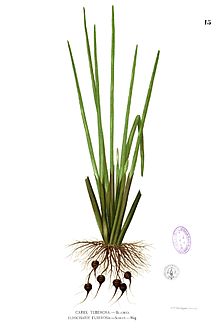
Back إيليوكاريس حلو Arabic ايليوكاريس حلو ARZ চেঁচোৰ Assamese Китайски воден кестен Bulgarian এলিওচারিস ডুলসিস Bengali/Bangla Muōi-sì CDO Eleocharis dulcis CEB Bahnička jedlá Czech Vandkastanje Danish Wasserkastanie German
| Chinese water chestnut | |
|---|---|

| |
| Illustration c. 1880[1] | |
| Scientific classification | |
| Kingdom: | Plantae |
| Clade: | Tracheophytes |
| Clade: | Angiosperms |
| Clade: | Monocots |
| Clade: | Commelinids |
| Order: | Poales |
| Family: | Cyperaceae |
| Genus: | Eleocharis |
| Species: | E. dulcis
|
| Binomial name | |
| Eleocharis dulcis | |
| Synonyms | |
| |
| Eleocharis dulcis | |||||||||||
|---|---|---|---|---|---|---|---|---|---|---|---|
| Traditional Chinese | 荸薺 | ||||||||||
| Simplified Chinese | 荸荠 | ||||||||||
| |||||||||||
| Cantonese name | |||||||||||
| Traditional Chinese | 馬蹄 | ||||||||||
| Simplified Chinese | 马蹄 | ||||||||||
| |||||||||||
| Nutritional value per 100 g (3.5 oz) | |
|---|---|
| Energy | 406 kJ (97 kcal) |
23.94 g | |
| Sugars | 4.8 g |
| Dietary fiber | 3 g |
0.1 g | |
1.4 g | |
| Vitamins | Quantity %DV† |
| Thiamine (B1) | 12% 0.14 mg |
| Riboflavin (B2) | 15% 0.2 mg |
| Niacin (B3) | 6% 1 mg |
| Pantothenic acid (B5) | 10% 0.479 mg |
| Vitamin B6 | 19% 0.328 mg |
| Folate (B9) | 4% 16 μg |
| Vitamin C | 4% 4 mg |
| Vitamin E | 8% 1.2 mg |
| Minerals | Quantity %DV† |
| Calcium | 1% 11 mg |
| Iron | 0% 0.06 mg |
| Magnesium | 5% 22 mg |
| Manganese | 14% 0.331 mg |
| Phosphorus | 5% 63 mg |
| Potassium | 19% 584 mg |
| Zinc | 5% 0.5 mg |
| Other constituents | Quantity |
| Water | 73.5 g |
| †Percentages estimated using US recommendations for adults,[3] except for potassium, which is estimated based on expert recommendation from the National Academies.[4] | |
Eleocharis dulcis, the Chinese water chestnut or water chestnut, is a grass-like sedge native to Asia, tropical Africa, and Oceania.[5] It is grown in many countries for its edible corms.[6]
The water chestnut is not a nut but rather an aquatic vegetable that grows in marshes, under water, or in mud. It has stem-like, tubular green leaves that grow to about 1.5 m (5 ft). The water caltrop, which also is referred to by the same name, is unrelated and often confused with the water chestnut.
The small, rounded corms have a crisp, white flesh and may be eaten raw, slightly boiled, or grilled, and often are pickled or tinned. They are a popular ingredient in Chinese dishes. In China, they are most often eaten raw, sometimes sweetened. They also may be ground into a flour form used for making water chestnut cake, which is common as part of dim sum cuisine. They are unusual among vegetables for remaining crisp even after being cooked or canned, because their cell walls are cross-linked and strengthened by certain phenolic compounds, such as oligomers of ferulic acid.[7] This property is shared by other vegetables that remain crisp in this manner, including the tiger nut, lotus root and spurge nettle root.[8] The corms contain the antibiotic agent puchiin,[9][10] which is stable to high temperature.[11] Apart from the edible corms, the leaves can be used for cattlefeed, mulch or compost.[12]
If eaten uncooked, the surface of the plants may transmit fasciolopsiasis.[13]
- ^ Francisco Manuel Blanco (O.S.A.) (c. 1880s). Flora de Filipinas [...] Gran edicion [...] [Atlas I].
- ^ Mesterházy, A. (2020). "Eleocharis dulcis". IUCN Red List of Threatened Species. 2020: e.T169077A1270989. doi:10.2305/IUCN.UK.2020-2.RLTS.T169077A1270989.en. Retrieved 31 October 2022.
- ^ United States Food and Drug Administration (2024). "Daily Value on the Nutrition and Supplement Facts Labels". FDA. Archived from the original on 2024-03-27. Retrieved 2024-03-28.
- ^ National Academies of Sciences, Engineering, and Medicine; Health and Medicine Division; Food and Nutrition Board; Committee to Review the Dietary Reference Intakes for Sodium and Potassium (2019). Oria, Maria; Harrison, Meghan; Stallings, Virginia A. (eds.). Dietary Reference Intakes for Sodium and Potassium. The National Academies Collection: Reports funded by National Institutes of Health. Washington, DC: National Academies Press (US). ISBN 978-0-309-48834-1. PMID 30844154. Archived from the original on 2024-05-09. Retrieved 2024-06-21.
- ^ "Plants of the World Online | Kew Science". Plants of the World Online. Retrieved 2023-02-06.
- ^ Flora of China, Vol. 23 Page 191, 荸荠 biqi, Eleocharis dulcis (N. L. Burman) Trinius ex Henschel, Vita Rumphii. 186. 1833. efloras.org
- ^ Phenolics and phenolic-polysaccharide linkages in Chinese water chestnut (Eleocharis dulcis) cell walls. Grassby Terri, Doctoral thesis, 2008, University of East Anglia (link)
- ^ McGee, Harold (2004). On Food and Cooking (Revised ed.). Scribner. p. 308. ISBN 978-0-684-80001-1.
- ^ Cite error: The named reference
Kay_1987was invoked but never defined (see the help page). - ^ Hodge, W. H. (January 1956). "Chinese water chestnut or matai—A Paddy Crop of China". Economic Botany. 10 (1): 49–65. doi:10.1007/BF02985317. S2CID 23026535.
- ^ Hao, Shu-xian; Liu, Xin; Zhao, Li-chao; Chen, Yong-quan (2005). "Study on the Effects of Puchiin Extract Antimicrobial Roperties". Food Science. Archived from the original on 2018-07-19. Retrieved 2016-12-04.
- ^ Cite error: The named reference
morton_1988was invoked but never defined (see the help page). - ^ Bhatti, H. S.; Malla, N; Mahajan, R. C.; Sehgal, R (2000). "Fasciolopslasis--a re-emerging infection in Azamgarh (Uttar Pradesh)". Indian Journal of Pathology & Microbiology. 43 (1): 73–6. PMID 12583425.
